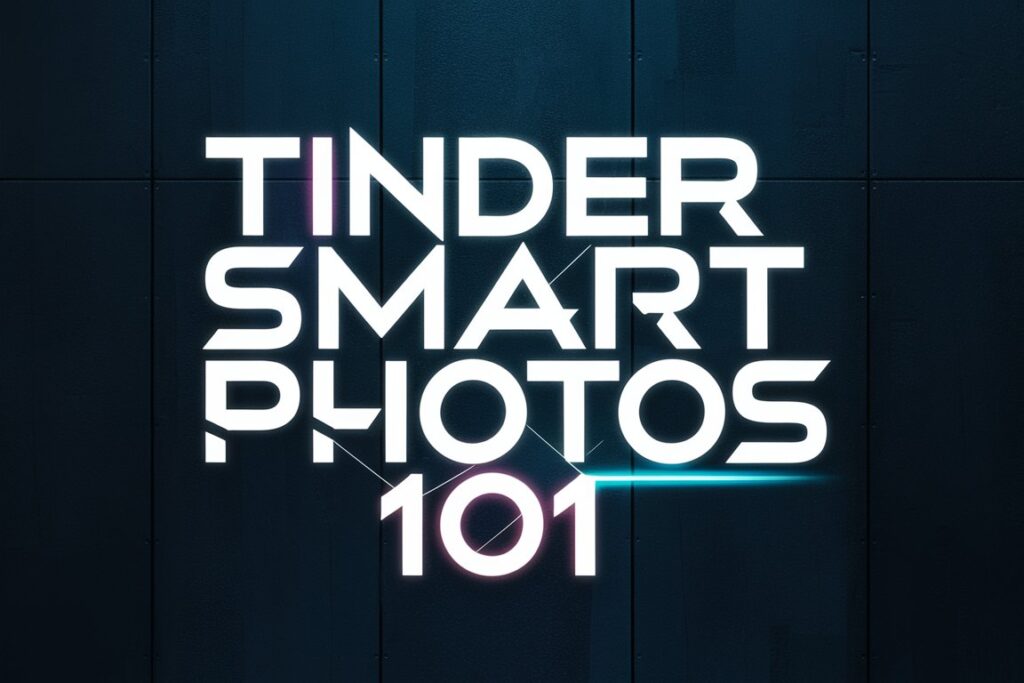Tinder’s ‘Smart Photos’ feature is like a personal assistant for your profile pictures. It tests them out to see which one gets you the most likes.
But is it really helping you get more matches? Let’s explore how ‘Smart Photos’ works and if it’s worth your time.
What is Tinder Smart Photos and How Does It Work?

The Tinder Smart Photos feature uses machine learning algorithms to optimize the performance of your dating profile. It works by:
- Uploading all of your potential Tinder photos into the Smart Photos tool. You need at least 2 images for it to function.
- The algorithm then tests these photos by automatically rotating the first picture shown on your profile.
- It tracks the number of “right swipes” each image receives to calculate its effectiveness. This metric is known as the swipe right rate.
- After sufficient data collection, Smart Photos locks your best-performing photo (highest SRR) as the first image on your profile.
Essentially, it conducts A/B testing to determine which picture receives the most positive reactions from other Tinder members. Similar to Bumble’s “Best Photo” option, the goal is displaying your most attractive or intriguing image first to boost your number of matches.
How Successful Is Tinder’s Smart Photo Feature?
While useful in theory, Tinder Smart Photos has some limitations in real-world application.
The accuracy of its algorithms depends entirely on people swiping right on their legitimately preferred photo, and then scrolling back to indicate interest again. However, the likelihood of most users putting in that effort is low.
Instead, people tend to make split-second decisions based on the current image displayed on their screen. So the data collected may not actually reveal which of your photos is objectively the strongest.
Additionally, Smart Photos can only optimize one image at a time when profiles should be evaluated holistically. The effect of your other photos, bio details, prompts, etc also play a role in your profile’s success.
So while algorithms may provide some useful insight, humans also have limitations around self-reported data. Relying entirely on Smart Photos is unlikely to maximize your profile’s match potential.
Should You Use Tinder Smart Photos At All?

Given its flaws, is Tinder Smart Photos still worth using? Here are some key reasons why you may want to avoid activating this feature:
1. Algorithms Have a Limited Understanding of Attractiveness
What constitutes an attractive photo differs vastly across individuals and cultures. Unlike humans, algorithms cannot accurately weigh more nuanced factors like personal preferences, humor, lifestyle signals, intimacy, etc.
So while data-driven recommendations seem logical, attractiveness is highly subjective. Smart Photos’ calculations often overlook the importance of user-defined connections.
2. Smart Photos Remove Your Control
Allowing an impersonal calculation to automatically dictate your profile images means relinquishing control. But desirability and self-presentation preferences are deeply personal.
Removing human oversight risks misrepresenting your brand if the computer selects unflattering or inaccurate photos against your wishes.
3. Great Photos May Be Overlooked
The ruthless optimization of Smart Photos could downplay some of your best pictures if other images perform marginally better. Just because an image gets more right swipes doesn’t mean it accurately conveys your appeal.
So some of your most attractive photos may unfortunately get buried by the algorithms.
4. Potential for Algorithmic Bias
Like all AI, Smart Photos’ machine learning models derive patterns from existing behavioral data. So limitations and biases in the training data get amplified into biased predictions.
For instance, if the current swiping patterns tend to favor Caucasian profiles, ethnic minorities may be disproportionately impacted by Smart Photos’ optimization choices. Relying blindly on these algorithms then becomes problematic.
In summary, Tinder Smart Photos offers some useful but limited suggestions. For the best results, manually curating your images while applying science-backed attraction principles is recommended instead.
How to Optimize Your Tinder Profile Photos
Constructing an attractive Tinder profile with effective photos is crucial for matching success. But with so many options to choose from, the selection process can feel overwhelming.
To simplify things, here is a step-by-step research-backed framework for selecting and sequencing your strongest Tinder pictures:
Choose Photos High in Visual Contrast
High contrast images clearly distinguish the subject from the background, making you “pop out” instead of blending in. These photos grab attention rapidly by activating the neural pathways for visual processing.
So choose pictures where you stand out prominently compared to your setting. Side-by-side comparisons of high vs low contrast images confirmed up to a 200% increase in perceived attractiveness with contrast.
Favor Simple, Uncluttered Images
The same neuroscientists also found that lower visual clutter and complexity improved Tinder photo ratings. This effect aligns with the brain’s general preference for simplicity.
When images contain too many distracting elements competing for attention, cognitive overload kicks in. But uncluttered scenes trigger faster processing, keeping users engaged.
So select clear, high-quality photos with minimal background noise. Strike a balance between simplicity and eliminating so much context it becomes boring.
Lead With Your Best Portrait Shot
While body shots matter, an appealing head-and-shoulders portrait makes the strongest lead image. Opening with your face invites users into your world right away to assess compatibility cues like facial symmetry, smile quality, skin health, etc.
Without decent facial visibility as a baseline of attraction, body aesthetic has little influence on swipe patterns.
So prioritize close-up photos showcasing your face before wider body shots in your Tinder lineup for maximum impact.
Pro Tip: Ensure your eyes are clearly visible to viewers. Eye contact triggers crucial first impressions around trust/likeability.
Include At Least One Full-Body Image
Once you’ve showcased your best facial close-up, add a full-length picture to provide additional context on your physicality, height, and style.
But don’t lead with distant body shots that hide your facial details. Research by Tinder’s in-house sociologist confirmed that silhouettes reduced perceptions of vitality, intelligence and friendliness.
So insert full body perspectives sparingly after more intimate facial images.
Choose Authentic Moments That Tell a Story
Rather than generic selfies or blatantly posed photos, select images depicting you genuinely engaged in activities you enjoy. Interactive moments that showcase your lifestyle and interests help establish a common ground to drive swipe decisions.
When your photos offer a window into your world by capturing a compelling moment, it feels more dynamic and attractive.
<callout> Pro Tip: Adding some mid-action motion blur suggests candidness while still keeping facial details clear. </callout>
Seek Outside Perspectives on Your Best Shots
We all have positive emotional attachments to certain selfies and group photos that may not actually showcase us at our best. Leverage outside opinions from friends with an objective eye to help determine your most swipe-worthy images.
Humans have biases and limitations in assessing their own attractiveness just like algorithms. Getting candid feedback helps reveal blindspots around which photos to use, avoid or improve.
Final Verdict: Should You Depend on Tinder Smart Photos?

Tinder’s Smart Photos provides moderately helpful suggestions around your best images. However, attractiveness and self-presentation require more nuanced human insight around emotions, subtleties, and personal preferences.
By combining science-backed photo selection frameworks with outside consulting perspectives, you can bypass Smart Photo limitations to showcase your finest visual assets in the optimal sequence for quality matches.
So by proactively applying these photo optimization best practices based on empirical evidence and collective wisdom, online daters can finally escape guesswork around presenting alluring yet authentic profiles.

